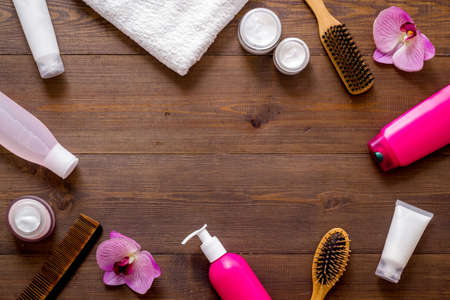1. Understanding Hair Fall in the Indian Context
Hair fall is a widespread concern for many Indians, and understanding its root causes is the first step towards effective management. In India, unique environmental factors such as pollution, hard water, and excessive heat often contribute to increased hair shedding. The constant exposure to dust and humidity, especially in metropolitan cities like Mumbai or Delhi, can clog scalp pores and weaken hair roots. Additionally, traditional Indian dietary patterns, sometimes lacking in vital nutrients like protein, iron, and vitamin D, can further aggravate the problem. Lifestyle habits also play a crucial role—stress from hectic work schedules, irregular sleeping patterns, and frequent use of chemical-laden hair products are common culprits. Moreover, cultural practices such as regular oiling with heavy oils or frequent hair styling with heat can have both positive and negative effects on scalp health. By recognizing these India-specific triggers, you can tailor your daily hair care routine with home remedies that not only address hair fall but also fit seamlessly into your cultural lifestyle.
2. Traditional Indian Oils for Stronger Roots
When it comes to combating daily hair fall, Indian households swear by the power of traditional oils. From our dadi’s coconut oil ka champi to the nourishing touch of amla and other desi oils, these time-tested remedies are an integral part of every hair care routine. Regular champi (hair oil massage) not only strengthens the roots but also deeply nourishes the scalp, helping to reduce hair fall naturally.
The Magic of Desi Oils
Let’s take a look at some popular Indian oils and their benefits:
| Oil | Main Benefits | How to Use |
|---|---|---|
| Coconut Oil | Deeply nourishes scalp, prevents protein loss, adds shine | Warm slightly and massage into scalp for 10-15 minutes before shampooing |
| Amla Oil | Rich in Vitamin C, promotes hair growth, reduces premature greying | Apply overnight or mix with coconut oil for extra nourishment |
| Bhringraj Oil | Strengthens roots, helps prevent dandruff, improves hair texture | Use twice a week as a pre-wash treatment |
| Almond Oil | Makes hair soft, repairs damage, packed with Vitamin E | Add a few drops to your regular oil blend for added softness |
How Champi Makes a Difference
A good old-fashioned champi is more than just a relaxing ritual—its a scientific way to boost blood circulation and deliver nutrients right to your roots. Our nanis and dadis always insisted on weekend oil massages for a reason! Regular use of these oils can:
- Nourish and moisturise dry scalp
- Reduce breakage and split ends
- Strengthen follicles for less hair fall
Pro-Tip for Best Results:
Mildly heat your chosen oil before massaging. Wrap your head with a warm towel post-massage for 20 minutes—this helps the oil penetrate deeper into the scalp. Rinse off with a gentle herbal shampoo for best results.
![]()
3. Herbal Hair Masks from the Indian Kitchen
When it comes to controlling daily hair fall, our Indian kitchens are treasure troves of natural remedies that have been passed down for generations. Let’s talk about some easy yet effective homemade hair packs featuring ingredients commonly found in every Indian household—fenugreek (methi), curry leaves, hibiscus, and curd. These natural wonders not only help strengthen your hair but also prevent breakage, keeping your mane festive-ready and full of life!
Fenugreek (Methi) Magic
Methi seeds are a staple in Indian beauty routines. Soak 2 tablespoons of fenugreek seeds overnight and grind them into a paste. Mix with a little curd to form a smooth mask. Apply this blend to your scalp and hair length, leaving it on for 30 minutes before rinsing off with cool water. Methi is rich in protein and nicotinic acid which help fight dandruff and nourish hair follicles for reduced hair fall.
Curry Leaves & Hibiscus Combo
Curry leaves aren’t just for tadka! Blend a handful of fresh curry leaves with 3–4 hibiscus flowers and add a dash of coconut oil for extra nourishment. Apply this herbal mask twice a week to revitalize your roots and add shine. Curry leaves are known to boost scalp circulation while hibiscus strengthens the strands, making this duo perfect for controlling seasonal hair shedding.
Curd Power Pack
Curd is a classic dadi-nani remedy for dry, brittle hair. Whip up half a cup of thick curd with one tablespoon of honey and apply generously from root to tip. Leave it on for 20 minutes before washing off with a mild shampoo. Curd deeply conditions the scalp, reduces itchiness, and supports healthy hair growth, making it an essential step in your home remedy routine.
How to Use These Herbal Masks?
For best results, use these masks once or twice a week as part of your regular hair care ritual. Always apply on clean, damp hair so that the nutrients can be absorbed better. After each application, follow up with a gentle herbal shampoo and avoid using heat styling tools immediately after treatment.
Pro Tip: Go Local!
Opt for fresh, locally sourced ingredients whenever possible. Not only do they retain more nutrients but they also support sustainable living—something that resonates with our Indian eco-conscious spirit! With these traditional kitchen remedies, you can celebrate stronger, healthier hair every day—just like our grandmothers did during every festival season.
4. Ayurvedic Cleansing and Conditioning Rituals
When it comes to controlling daily hair fall, embracing time-honoured Ayurvedic cleansing and conditioning rituals can make a significant difference. Indian households have trusted natural alternatives for generations—ingredients that not only cleanse gently but also nourish the scalp and strengthen hair roots. Let’s explore how you can incorporate staples like shikakai, reetha, and aloe vera into your weekly hair care routine, all while staying true to Indian traditions.
Shikakai: The “Fruit for Hair”
Shikakai, literally translating to “fruit for hair” in Hindi, has been a go-to herb for gentle cleansing. Rich in saponins, vitamins C and D, shikakai maintains the scalp’s pH balance and leaves hair soft without stripping away its natural oils. It’s suitable for all hair types and especially effective during the hot Indian summers when sweat and pollution can irritate the scalp.
Reetha: Nature’s Soapnut
Reetha, or soapnut, is another staple found in Indian homes. Known for its natural foaming properties, reetha helps remove dirt and excess oil from the scalp without causing dryness. Its antibacterial benefits aid in keeping dandruff at bay—a common concern during monsoon season.
Aloe Vera: Soothing & Nourishing
No Indian home remedy list is complete without mentioning aloe vera. This succulent has been used for centuries to soothe irritated scalps, promote hair growth, and provide deep hydration. Aloe vera gel can be applied directly to the scalp or mixed with other herbal powders for added nourishment.
Quick Comparison of Ayurvedic Cleansers
| Ingredient | Main Benefit | How to Use |
|---|---|---|
| Shikakai | Gentle cleansing, prevents dryness | Mix powder with water; apply paste to scalp and rinse off after 10 mins |
| Reetha | Natural cleanser, controls dandruff | Soak overnight; boil and use the liquid as shampoo |
| Aloe Vera | Soothes scalp, adds moisture | Apply fresh gel to scalp; leave on 15 mins before rinsing |
Cultural Tip:
For an authentic experience, many Indians prepare these ingredients fresh at home or buy them at local markets in their purest form. Weekly “champi” (oil massage) followed by an Ayurvedic wash is a cherished self-care tradition across India—perfect for bonding with family and keeping hair strong and beautiful throughout every festival season!
5. Desi Dietary Tips for Healthy Hair Growth
If you want to flaunt luscious locks that shine brighter than your Diwali diyas, your daily diet needs some desi magic! India’s rich culinary heritage is packed with nourishing ingredients that promote healthy hair from the inside out. Here are some easy-to-follow Indian food and drink suggestions that you can incorporate into your routine for strong, vibrant hair and a happy scalp.
Curry Leaf Water: The South Indian Secret
Every South Indian kitchen swears by curry leaves, or “kadi patta,” for hair strength. Boil fresh curry leaves in water, strain, and sip this green elixir on an empty stomach. Packed with antioxidants, iron, and amino acids, it supports hair follicles and reduces hair fall naturally. Make it a part of your morning routine for best results!
Nuts & Seeds: Crunchy Powerhouses
Almonds (badam), walnuts (akhrot), sunflower seeds, and flaxseeds are loaded with omega-3 fatty acids, biotin, and Vitamin E—essential nutrients for healthy hair growth. Snack on a handful daily or sprinkle them over your breakfast poha or curd for a tasty crunch that’s also #hairgoals approved.
Amla Juice: The Classic Superfood
Amla, or Indian gooseberry, is a go-to remedy in every Indian household. Rich in Vitamin C, amla juice helps boost collagen production, which is vital for new hair growth. Drink a small glass of fresh amla juice in the morning to rejuvenate your scalp and strengthen roots from within.
Spiced Buttermilk (Chaas) for Scalp Hydration
Hydration is key! Chaas—made with dahi (curd), jeera (cumin), and coriander—keeps your body cool and your scalp nourished. This probiotic drink improves digestion and ensures better nutrient absorption for hair health. Sip it during lunch like any true-blue desi family would!
Leafy Greens & Colourful Veggies
Add palak (spinach), methi (fenugreek leaves), carrots, and beetroots to your meals. These vibrant veggies are rich in iron, beta-carotene, folic acid, and silica—all vital for preventing hair thinning and promoting growth. Try a classic sabzi or juice blend to keep things exciting on your thali.
Pro-Tip: Rotate Your Ingredients
Don’t stick to just one remedy! Indian kitchens are treasure troves—mix up your nuts, experiment with different leafy greens, or try seasonal fruits like guava and papaya for variety. Remember, consistency is key for seeing those #hairtransformation results!
Your path to gorgeous tresses begins at home—with these simple yet powerful desi dietary habits lighting up your daily hair care routine.
6. Tips to Minimize Daily Hair Damage
In the hustle and bustle of Indian cities, our hair faces daily challenges from pollution, humidity, and heat. To maintain strong and healthy tresses, it’s essential to follow some time-tested Indian methods for minimizing hair damage. First, protect your hair from harsh environmental factors by covering your head with a dupatta or scarf when outdoors. This simple habit shields your strands from dust, sun rays, and pollution—an age-old trick passed down by Indian grandmothers. Second, instead of leaving your hair open, tie it into classic braids or plaits (chotis). Not only do these traditional styles look chic during any festive season, but they also prevent tangling and reduce breakage caused by constant friction with clothing or wind. For extra nourishment, apply a few drops of coconut or amla oil before braiding; this locks in moisture and strengthens the roots. Third, limit the use of heat-styling tools like straighteners and blow dryers. Embrace your natural texture and opt for heatless styling methods such as overnight braids for soft waves or using rollers for volume. If you must use heat, always apply a herbal heat protectant serum infused with Indian ingredients like aloe vera or hibiscus. By integrating these easy practices into your daily routine, inspired by Indian home remedies and culture, you can keep your mane healthy, shiny, and ready for any celebration!
7. When to Seek Professional Help
While Indian home remedies—like oiling with coconut or amla oil, using hibiscus hair masks, and rinsing with neem water—can work wonders for mild hair fall, its important to know when to consult a specialist. If your hair fall continues despite diligently following these traditional treatments, it may be time to reach out to a dermatologist or trichologist in India.
Persistent hair loss could be a sign of underlying health issues such as hormonal imbalances, scalp infections, or nutritional deficiencies that require medical intervention. In India, factors like pollution, stress from city life, and even hard water can add to the problem. A qualified doctor can diagnose the root cause and recommend tailored solutions—be it ayurvedic supplements, medicated shampoos, or advanced therapies suited for Indian hair types and climates.
Remember: Self-care is beautiful, but your hair deserves expert care too. Dont hesitate to book an appointment if you notice excessive shedding, patchy bald spots (alopecia), or scalp irritation that home remedies cannot fix. Early intervention from professionals ensures you get the best of both worlds: the wisdom of Indian traditions and the precision of modern science.


